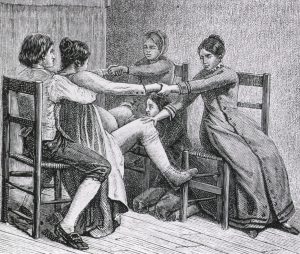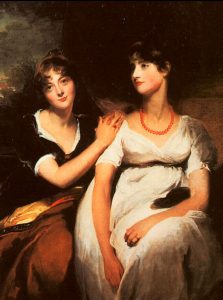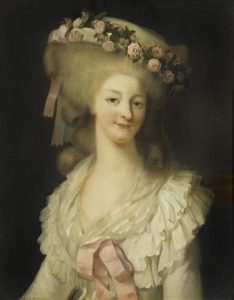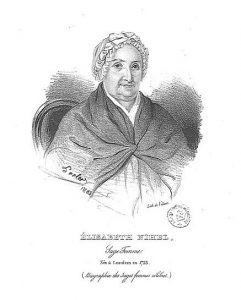Would polite Society censure Miss Anne de Bourgh for sitting as a gossip during her friend’s delivery? This question was one of the first I asked when researching my Regency novel, Rosings Park, which is based on characters in Jane Austen’s Pride and Prejudice. It isn’t an easy question to answer. Gossiping was a centuries-old practice in which a pregnant woman’s mother, sisters, and female friends and neighbors attended her delivery to provide comfort and support. During the Regency era, when nearly all women gave birth at home, childbirth was a social occasion; even aristocratic women sat as gossips. In Rosings Park, Mrs. Matilda (Tilly) Sparke, is pregnant with her first child. Because she is troubled by the memory of her mother’s death in childbirth, Tilly wants support from those closest to her—Anne, her dearest friend, and Margaret, her married sister. Would it have shocked all Society for the unmarried Anne to attend a delivery? In seeking an answer, I asked a few questions of my own.

A pioneer birth scene showing a woman sitting on her husband’s lap while a midwife and gossips attend her (Source: History of Medicine)
Would Tilly be Uncomfortable Having Anne Attend?
Immodesty was not a deterrent to Anne’s attending Tilly’s delivery. Unlike the lady shown in the image, Tilly would not be virtually naked through her trial. In fact, it was customary for the pregnant Regency woman to wear a shift during her delivery. The surgeon and physician Sir Charles Mansfield Clarke suggested the pregnant patient wear “a shift tucked up under the arms with a short petticoat placed about the hips which is to be removed after labour and the dry shift drawn down.”1 Moreover, Anne was a considerate friend who stood at the head of the bed to offer comfort; she was not in a position to view any intimate particulars of the birthing.
What Does the Regency Medical Literature Say about Gossips?
I read and took notes on 12 books related to midwifery practice written by doctors, surgeons or midwives; these medical texts were published between 1752 and 1825. None of these practitioners wrote about “gossips,” but nearly all mentioned their pregnant patients’ friends, assistants, attendants or by-standers. In no case did a practitioner specify that attendants were or should be married. I found no evidence in my small sampling of the Regency medical literature to indicate that a friend had to be married to sit as a gossip.
Did It Matter that Anne Had Reached Her Majority?
I believe it was significant that Anne had reached her majority—that is, she was past the age of 21. (In Rosings Park she is 26 years old, two years younger than Mr. Darcy.) The 1771 edition of the Encyclopaedia Britannica states that “twenty-one is called full age, a man or woman being then capable of acting for themselves, managing their affairs, making contracts, disposing of their estates, and the like.”2 The 1910 edition reinforced the opinion: under English law a person’s life is divided into two periods: infancy, which lasts until the person reaches his or her 21st year, and manhood or womanhood.3 Anne was long past the age of majority. She might be influenced by her mother or persuaded by close neighbors, but she could choose to attend her friend’s delivery. Had she been younger— say, 16 or 18 years of age—the argument for her sitting as a gossip would be harder to support.

Jane and Elizabeth Bennet were as close as the daughters of Colonel Thomas Carteret Hardy appear here (Source: courtesy of www.thomas-lawrence.org) (CC BY-NC-ND-3.0)
Would Elizabeth Bennet Attend Her Sister Jane?
Despite being an adult under the law, would Anne have refused her friend’s request because she feared Society would criticize her? Here I considered the other characters in Austen’s drama: Jane and Elizabeth Bennet. I imagined a scenario in which Jane has married Mr. Bingley and is pregnant with her first child, whereas Elizabeth has not married Mr. Darcy or any other man. Who would Jane call for comfort during her delivery? Her mother, Mrs. Bennet? Her younger married sister, Mrs. Lydia Wickham? Or her dearest but unmarried sister, Elizabeth? I think she would call on Elizabeth—who would readily serve—and hope to high heaven that neither her easily agitated mother nor the too lively Lydia would be available to attend her.
Another thought on this issue: By the time Jane married Mr. Bingley, got pregnant and reached the point of delivery, Elizabeth would likely have achieved her majority, giving her more freedom to act on her personal wishes. (Recall that she told Lady Catherine that she was not yet “one and twenty,”4 which suggests she was 20 years of age when she visited Rosings Park with the Collinses.) It seems to me that if Mrs. Bennet failed to persuade Lizzie not to walk the three miles to Netherfield to check on Jane’s recovery, she probably could not prevent her attending Jane’s delivery.

A colorized version of Jane Austen (Source: Wikimedia Commons
Would Jane Austen Attend Her Sister, Cassandra?
Having asked the question about Jane and Elizabeth, I next considered the author and her older sister, Cassandra. When Cassandra was in her early twenties she became engaged to Mr. Thomas Fowle, a clergyman who died in the West Indies just a few weeks before he was scheduled to return to England.5 (A sad tragedy for Cassandra and both families.) But imagine that Mr. Fowle did not succumb to yellow fever but sailed home safely and married Cassandra. When Cassandra becomes pregnant, would she ask her only sister, Jane, to sit as a gossip, even though Jane was unmarried? I believe she would do so, and she would want her mother as well, for Mrs. Austen appears to have been a sensible woman5 and nothing like Mrs. Bennet.
Was Jane Austen Shy About Pregnancy?
Here’s a truth widely acknowledged: Jane Austen’s novels are discreet about pregnancy. Describing Mrs. Charlotte Palmer’s condition in Sense and Sensibility, readers are told “She expects to be confined in February.”6 Austen herself was not shy about speaking her mind on the subject. After learning that the wife of Henry Austen’s bank partner was in the family way, Jane wrote to Cassandra, “poor Woman! how can she be honestly breeding again?” About the pregnant wife of her brother Frank, she wrote Cassandra that Mary seldom seemed well: “Little Embryo is troublesome I suppose.” When she learned one of her niece’s aunts was expecting her 18th child, she recommended to “her and Mr D. the simple regimen of separate rooms.”7 Jane Austen wrote frankly about pregnancy and its consequences in her private letters if not in her novels.

Cassandra Austen’s Silhouette (Source: Wikimedia Commons) [PD-1923]
Was It Understood that Only Married Women Sat As Gossips?
While I was reading Judith Lewis’s book on courtship, marriage and childbirth among aristocratic women who gave birth between 1760 and 1860,1 it occurred to me that it might simply have been understood that only married women sat as gossips during delivery. Inexplicably the image that came to mind was the haka performed regularly by the New Zealand rugby team before the start of their international games. Imagine I say to you, “The New Zealand All Blacks team has been doing the haka since 1905.” Or I might say, “A list of NFL starting quarterbacks can be found on Wikipedia.” You know I am speaking of men in these cases because you live in today’s culture and likely know a little about New Zealand, professional rugby or the U.S. National Football League.
It is possible, therefore, that everyone in the Regency period knew that only married women attended a birth. The information is not written down because it was simply understood within the culture. But a question arises: Would it be improper for a married but childless woman to attend a delivery? In other words, if we draw on the Jane Bennet scenario above, might the married but childless Lydia Wickham have attended Jane’s delivery without being censured?

Marie Therese de Savoie, Princess de Lamballe (Source: Wikimedia Commons)
By chance, I found an instance that sheds light on this question. In January 1767 Princess Maria Teresa of Savoy-Carignan married Louis Alexandre de Bourbon, known as the Prince de Lamballe. The Prince, a womanizer of the first water, remained faithful to her for roughly three months before taking up his former life of debauchery; he died of a venereal disease sixteen months after his marriage, leaving the 19-year-old Princess de Lamballe a considerable fortune. Even though she was childless, she attended the birth of Louis-Philippe, the future King of France, in October 1773. Here is one example where a married but childless lady attended a birthing; presumably she had some experience of sex but knew little, if anything, about childbirth.

The confident, capable 18th-century British midwife: Elizabeth Nihell (Source: Wikimedia Commons)
Would the Midwife Disapprove?
A midwife ruled the lying-in chamber and, indeed, the entire household during a pregnant woman’s delivery.8 She might call for adjusting the draperies, order the removal of furniture and make dietary changes to ensure her patient’s success, but she had absolute authority over her patient and the setting. If a gossip was loud, talked too much, or made her patient nervous, the midwife would toss her out on her ear. In short—no inebriated, rude, or irritating gossips were allowed.9 Thus, so long as Miss de Bourgh was circumspect, helped comfort her friend and did not interfere during the delivery, the midwife was not likely to object to Anne’s remaining at Tilly’s bedside.
How Far Would Sisters Go to Help Each Other?
I believe Anne de Bourgh was willing to risk Society’s censure for a simple reason: her first concern was comforting a friend whom she thought of as a sister. Some people might think her sitting as a gossip was unusual. Some might criticize her—think of Caroline Bingley and Mrs. Hurst, who were offended by Elizabeth Bennet’s walking through the countryside alone to visit a sick Jane at Netherfield Park. Frankly, I think it’s likely that many people in the village of Hunsford would be more shocked to learn that Tilly allowed a man-midwife to attend her!
We must remember that people living during the Regency era were closer to birth and death than many of us in North America are today. Nearly all women gave birth at home,10 and their confinements were not solitary: children and husbands participated. In one instance, the teenaged, single brother of a pregnant aristocrat hovered nearby during her delivery. Although his family thought his presence was “‘not quite right,’ they seem to have been more amused than outraged.”1
In short, I believe aristocratic women who recalled their own trials and believed themselves lucky to survive childbirth would be hard-pressed to criticize Anne. They would think first of Tilly’s need for the comfort of a friend’s handhold during delivery—especially as her mother was no longer living—and forgive any social transgression after. What’s needed now is thorough research to settle the matter.
Sources:
1Lewis, Judith Schneid. In the Family Way: Childbearing in the British Aristocracy, 1760-1860. New Brunswick: Rutgers University Press, 1986, pp. 5-7, 162, 177.
2Anon. Encyclopaedia Britannica or, A Dictionary of Arts and Sciences Compiled upon a New Plan, Vol. I (Edinburgh, 1771), p. 37 (PDF p. 55).
3Anon. Encyclopaedia Britannica: A Dictionary of Arts, Sciences, Literature and General Information, Vol. I, 11th ed. (New York, 1910), p. 372-373 (PDF p. 415-416).
4Austen, Jane. Pride and Prejudice. London: Penguin Books, 1996, p. 162.
5Halperin, John. The Life of Jane Austen. Baltimore: The Johns Hopkins University Press, 1984, pp. 19, 62, 156, 160, 164-165.
6Austen, Jane. Sense and Sensibility. Kindle edition, loc 25420 (chapter 19).
7Selwyn, David. Jane Austen and Children. London: Continuum, 2010, pp. 5-13.
8Wilson, Adrian. The Making of Man-Midwifery: Childbirth in England, 1660-1770. Cambridge, MA: Harvard University Press, 1995, pp. 25-49.
9Cressy, David. Birth, Marriage, and Death: Ritual, Religion, and the Life Cycle in Tudor and Stuart England. Oxford: Oxford University Press, 1999, pp. 55.
10Forbes, Thomas R. The regulation of English midwives in the eighteenth and nineteenth centuries. Med Hist. 1971(Oct);15(4):352-362.
